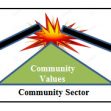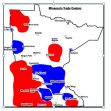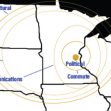
Freedom of Residential Choice
Do all Urban Dwellers want to Live in an Apartment and Ride the LRT? It is an oxymoron that individuals want to live in a high density environment when they keep buying homes in the suburbs. Ever since man appeared on this earth, the question of where is the best place to live has been based upon survival, i.e. physical safety or employment security. For the first time in history, man can live wherever he/she wants based upon ACCESS to technology,their own personal LIFESTYLE and a compatible VISION with their chosen community.
But the status quo dies hard
The public sector continually pushes for more density to support their transportation system and to eliminate the automobile. They push for neighborhoods where people can bike and walk everywhere. To the objective mind, this almost sounds like their goal is to support rural small towns which already have these attributes. Unfortunately, empowering a Freedom of Residential Choice throughout the Smart Region is not the governmental policy goal.
Research done by the “American Community Survey 2013-17 indicates that the urban core and early suburbs lost 20% of the 2010 market share to the Later Suburbs and the Ex-urban communities in just five years. This reduces their share of the overall 2015 market to 37.2%.The Later Suburbs grew at an annual rate of 1.70 percent. This is 70 percent greater than the overall rate of 1.01 percent and more than 80 percent higher than the .93 percent increase in the urban core/CBD. All areas except the Later Suburbs grew more slowly than the overall major metropolitan rate, though the ex-urbs grew nearly as fast.” The growth is outward- not inward. If that is the lifestyle that individuals want, the community must ensure that they are ‘allowed’ to do it by ensuring that the right policies and investments are in place to support it. The more we spend on trying to maintain the status quo, the more it will cost when government is forced to acknowledge that they cannot win against the market.
To Centralize or Decentralize? That is the Question!
Although the approach to broadband deployment has been the pursuit of low hanging fruit which has greatly reduced the real mission of extending access to everyone, the need for a systemic deployment is clear. As my last post pointed out, it is the Suite of Telecommuting Applications (SoTA) that will revitalize our rural communities and enable a population redistribution based upon lifestyle choice. Once the technology is deployed, the applications are provided and the communities get organized will we really know what the Smart Region will become. One thing is increasingly clear, while the urban politicians claim that everybody is flocking to the cities based upon extrapolation, looking forward it appears they may investing in a centralized world when the real future is decentralized. Only the community itself will determine which vision is correct.
Coming up in our next post:
The Community Dialogue Process and Recommendations
Things you can do …
- Read my book: “Slaying the Status Quo”
- Share what you think are the problems we face and how they can be addressed.
- Respond to this post with a comment below.
- Contact me John Sanger by email or phone 651-486-8408
 SmartRegions.US is a community-driven strategy for restoring neighborhood viability by integrating rural-urban economies.
SmartRegions.US is a community-driven strategy for restoring neighborhood viability by integrating rural-urban economies.



